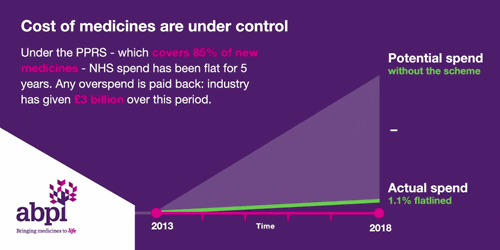What was the PPRS?
The UK has a number of different mechanisms for ensuring value for money and cost control in the NHS. In addition to NICE which evaluates cost-effectiveness, the Pharmaceutical Pricing Regulation Scheme (PPRS) helps controls the amount the NHS spends on new medicines.
The industry works very closely with the government to strike the right balance between making sure that patients can get access to the medicines they need, to make sure that the NHS finances are sustainable, and also to make sure the industry can continue to invest in medicines in the future.
We've done that through negotiating a voluntary agreement that runs for five years, we've done that, every five years since the 1950s. The current agreement was signed during a period of real economic difficulty for the UK in 2013, and that agreement the industry did its part in that time austerity by making sure that the spend on branded medicines remained flat for that period of time. So, if the NHS used more medicines, then the industry pays back money.
And over that period of time, we've known that with an ageing population, the NHS has treated more patients with a flat budget. So, as the NHS has treated more patients, the industry has indeed paid back, and we’ve paid back almost £3billion in that time.
We're currently in discussions with government and the NHS about a new scheme, starting next year.
What was the PPRS?
This voluntary scheme has been in place for over 50 years and helps to provide the pharmaceutical industry and the Government with a stable environment to introduce medicines into the NHS, making sure patients can get access to the newest, most effective treatments available, while helping to sustain a thriving UK pharmaceutical industry.
Cost of medicines are under control
A voluntary scheme has been negotiated every five years, with the next scheme due to start in January 2019.
The current PPRS – negotiated in 2014 at a time of austerity in the UK – sought to cap the growth of NHS spend on branded medicines at an agreed rate, with any overspend paid back to the NHS. This was to provide stability of spend to the NHS and offer an incentive to use new medicines at no extra cost.

We know with absolute certainty that the growth of NHS’ spend on medicines under this PPRS over five years has remained stable at 1.1%. When taking inflation into account, that’s actually a 0.4% decline. By contrast the wider NHS spend has risen at 3.3% over the same period.
Companies who choose not to be in the voluntary scheme are subject to statutory pricing controls which impose a set price cut to medicines not within the PPRS scheme. Older – generic – medicines do not have a similar scheme, however, for the most part strong competition keeps prices extremely low.
To date, the industry has paid back over £3 billion to the Department of Health and Social Care for NHS spending above the cap. That’s around a million pounds a day.
Last modified: 23 May 2024
Last reviewed: 23 May 2024